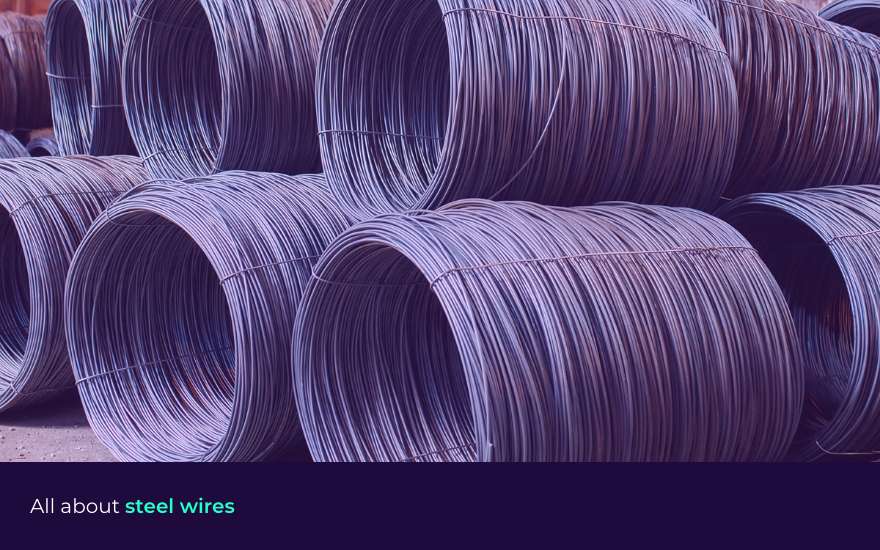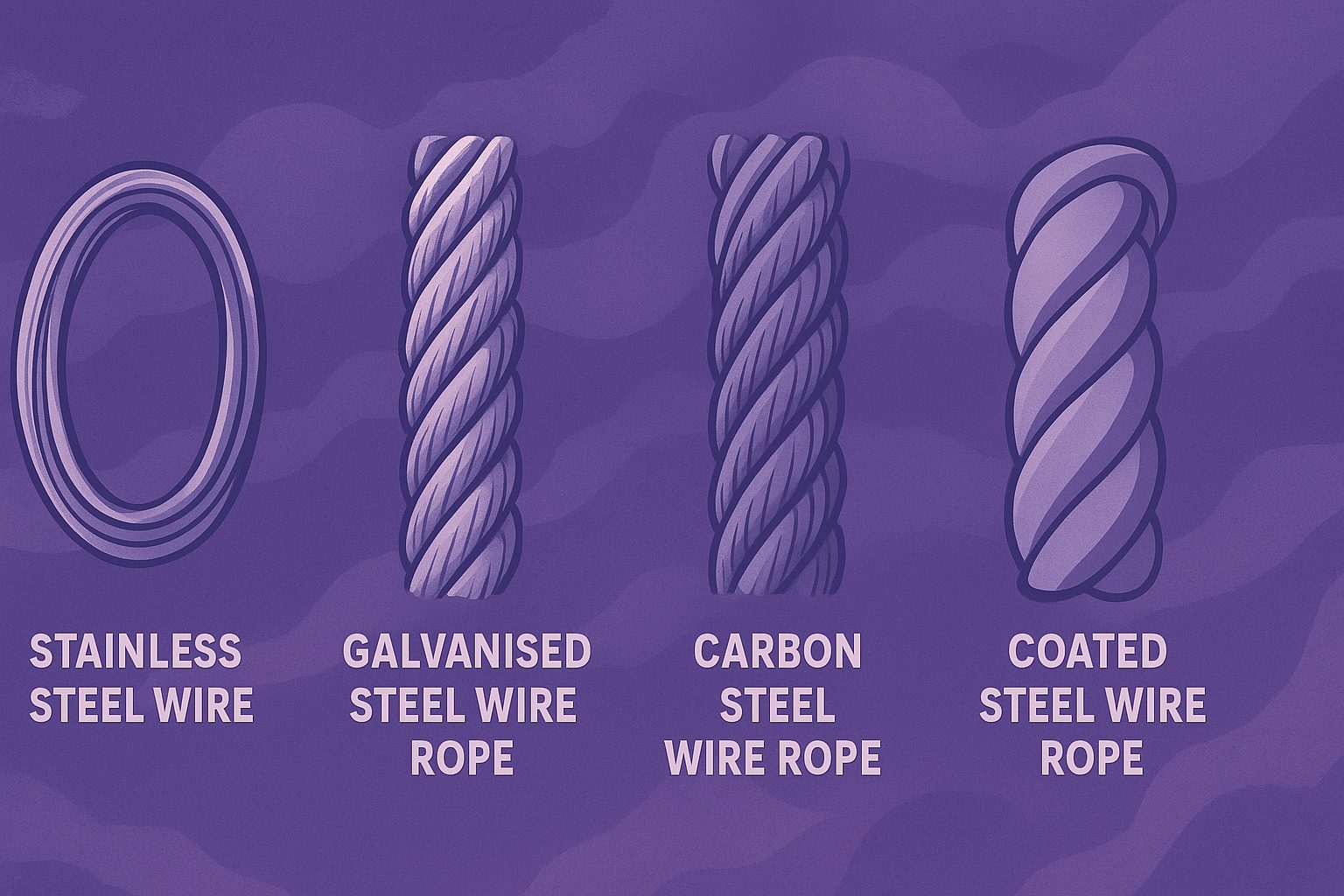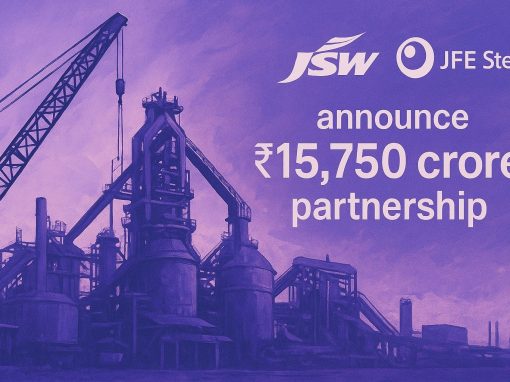Table of Contents
- What is Steel Wire?
- How is Steel Wire Made?
- Benefits of Steel Wires
- Types of Steel Wires
- Technical Properties of Steel Wires
- Applications of Steel Wires
- Steel Wire Market Overview in India
- Recent Innovations in Steel Wire Manufacturing
- Maintenance and Safety Tips
- How to Choose and Source Steel Wires
- Conclusion
Steel is known to be an important raw material for various industries. We have already explored various steel products such as steel plates, TMT bars, aluminium coils, and so on. Just like aluminium coils, steel wire is a versatile product and has varied applications. This article will explain, what steel wire is, how steel wire is made, its benefits and applications.
What is Steel Wire?
Steel wire is a flexible, cylindrical strand made of steel. It is used for various applications, however, one of its important uses include lifting heavy materials in construction, logistics, infrastructure industries. Its manufacturing process generally involves several steps such as rolling, surface heating, etc.
How is Steel Wire Made?
Step 1: Generally, the raw material for making steel wires include steel rods which are supplied by integrated or mini steel plants. Steel rods are often made from billets using a hot rolling process.
Step 2: Surface treatment is the next step. Descaling and surfacing coating are done, which further enables the drawing process.
Step 3: The third step of making steel wire is drawing. The rod is brought to the drawing machine and the required diameter wire is drawn.
Step 4: Then, the drawn wire undergoes the patenting process. Patenting is a type of heat treatment wherein the wire is heated at about 900°C and then quenched into molten lead at 500°C.
Step 5: Intermediate drawing takes place.
Step 6: The last step is stranding and closing. Wire and strands positioning are confirmed and closed.
Note: The process of making steel wires may vary depending on a manufacturer
Various companies produce steel wires. Global Wires Business (GWB), a division of Tata Steel, is one of the largest steel wire manufacturers in the world.
Benefits of Steel Wires/Ropes
Steel wire ropes are one of the important components for many industries. Here are some of the benefits of steel wires.
- Corrosion resistance: Steel wires can withstand harsh weather conditions, hence corrosion is less likely. Sometimes, steel corrosion can take place under certain conditions however, it can be avoided with timely maintenance.
- Tensile strength: Steel wire showcase excellent tensile strength, which makes them an ideal choice for use in infrastructure construction.
- Ductility: Many metals deform under tensile strength however, steel wires do not. This makes steel wires an ideal choice for use in electrical cables, etc.
Types of Steel Wires
Depending on the raw material used, the manufacturing process and its usage, there are many types of steel wire available in the market. Some of the popular types of steel wires are listed below:
Stainless steel wire: Stainless steel properties makes it a robust material that does not corrode quickly. Hence, stainless steel wire ropes are ideal for the use where it may come in contact with water and humidity. It is best suited for industries such as marine, architecture, etc.
Galvanised steel wire ropes: Galvaised wire ropes are coated with molten zinc. As a result, galvanised steel wire ropes display the features such as high strength, corrosion resistance, etc. Therefore, these wire ropes are ideal for general engineering purposes.
Carbon steel wire ropes: There are low and high carbon content steel wire ropes. While carbon adds strength to it compromises flexibility. Hence, low carbon steel wire ropes are used where more flexibility is required. On the other hand, high carbon steel wire ropes are used where the focus is more on strength and not on flexibility.
Coated steel wire ropes: Coated wire ropes are generally coated or jacketed with materials such as polypropylene, PVC, nylon, etc. Such coating offers protection to the steel wire against wear and tear and also corrosion.
Apart from the four types mentioned above, there are various other types of steel wire ropes. Steel wire ropes come in different sizes, such as 3mm, 6mm, 9mm and so on. Additionally, custom made steel wires are made of different types of steel and coating also differs as per the application.
Technical Properties of Steel Wires
Steel wires are made to suit different industrial needs. Their strength, size, and flexibility depend on the type of steel and how the wire is processed. The table below shows the typical technical properties of steel wires used in India.
| Property | Description/Typical Range | Notes |
| Tensile Strength | 400 – 1,800 MPa | Varies by type; mild steel wires have lower strength, while high-carbon and stainless wires have higher strength. |
| Wire Diameter | 0.1 mm – 30 mm | Thin wires are used in cables and springs; thicker wires are used in cranes and construction. |
| Elongation | 1% – 10% | Shows ductility. Higher elongation means the wire can stretch more before breaking. |
| Modulus of Elasticity | Around 200 GPa | Measures stiffness; most steel wires maintain a similar elasticity level. |
| Density | 7.85 g/cm³ | Standard for steel; affects total weight of wire used in large projects. |
| Melting Point | 1,370 – 1,540 °C | High melting point makes steel wires suitable for high-temperature uses. |
| Coating Type | Zinc, PVC, Nylon, or none | Coatings improve corrosion resistance and durability. |
| Magnetic Properties | Magnetic (except stainless steel) | Important for electrical and electronic uses. |
| Grades Commonly Used | Low Carbon (AISI 1005–1020), High Carbon (AISI 1040–1080), Stainless (AISI 304, 316) | Grade selection depends on required strength and corrosion resistance. |
Key takeaway:
Steel wires come in many grades and sizes. Always match the tensile strength, coating, and diameter to the specific task – whether it’s for construction, lifting, or automotive use.
Applications of Steel Wires/Ropes
Steel wire ropes are used for various purposes. Right from the creative music industry to hard-core oil and gas industry, steel wire ropes are present everywhere.
Mining: Mining wire ropes need to withstand harsh environments especially, in the case of underground mining. Therefore, these wires need to be of high quality and strong. As a result, they are made of high-carbon steel.
Logistics: Steel wires are widely used in the logistics industry. They are one of the critical components of cranes that carry bulk and heavy materials. These cranes are mainly deployed in port areas where environment conditions are humid. Therefore, it requires corrosion resistant material. Hence, galvanised steel wires ropes are usually used in the logistics industry.
Construction: In the construction industry various equipment are used to carry heavy materials such as cement blocks, and other raw material and machinery. Also, they are used in securing rebars, lifting elevators carrying materials and so on. Depending on the uses, multiple types of steel wires are used in the construction industry.
Manufacturing: In any manufacturing plant, materials need to be carried from one station to another. For which, various material handling equipment are used. These require steel ropes to carry materials that are heavy and big in size. Depending on the purpose, varied kind of steel wire ropes are used in the manufacturing industry.
Transportation: There are many kinds of wires used in the automotive as well aerospace industries. Within the aircraft or car, these wires need to withstand harsh environment such as heat, high altitude, pressure, and so on. Hence, these wires need to be corrosion resistant and capable of withstanding harsh environment. Depending on the project steel wires are chosen. Moreover, steel wires are also used activities such as transportation via trams, metros, etc.
Apart from the industries mentioned above, steel wires are extensively used in many other sectors such as oil and gas, entertainment, infrastructure, general engineering, etc.
Steel Wire Market Overview in India (2025)
- India’s steel wire market is expected to grow at a CAGR of about 5.6% between 2025 and 2029.
- The market value is estimated at around USD 10 billion in 2025.
- Growth is mainly driven by infrastructure projects such as Smart Cities, highways, metro lines, and affordable housing.
- The construction industry is the largest consumer of steel wires in India.
- The automotive sector uses steel wires for springs, cables, fasteners, and seat frames.
- The manufacturing and logistics industries depend on steel wires for material handling, cranes, and heavy equipment.
- Demand for steel wire rods, a key input, reached USD 9,195 million in 2022 and is expected to grow at 6.6% CAGR through 2030.
- Market expansion is supported by urbanisation, industrialisation, and export opportunities.
- Raw material price volatility and cheap imports continue to challenge domestic producers.
- Overall, India’s steel wire market is set for steady and sustainable growth in the coming years.
Recent Innovations in Steel Wire Manufacturing
- Automation and robotics are being more widely used in steel wire plants to handle tasks such as drawing, galvanising, stranding, and quality inspection.
- AI-powered quality control systems now detect surface defects, dimensional errors, or inconsistencies in coatings, reducing waste and rework.
- Smart sensors and Internet of Things (IoT) are used to monitor temperature, tension, and material flow in real time during wire manufacturing. This allows quicker corrections and better consistency.
- Predictive maintenance driven by data analytics and machine learning helps plants avoid unplanned downtime by forecasting when equipment may fail or need servicing.
- Digital twin technology is being adopted to create virtual models of the manufacturing line. These models are used to simulate process changes, test improvements, and optimise production without disrupting actual operations.
- Green steel methods are gaining traction, for example using hydrogen-based reduction instead of coal in ironmaking, which reduces carbon emissions significantly.
- New coatings and galvanising techniques are being developed that use less zinc or more efficient bath control, while improving corrosion resistance and durability.
- Use of recycled scrap steel is increasing in steel wire production, lowering raw material costs, and reducing environmental impact.
Maintenance and Safety Tips for Steel Wires
Steel wire ropes work under high stress and must be maintained carefully to ensure safety and long service life. Regular inspection and timely upkeep reduce the risk of accidents, equipment failure, and costly downtime.
Routine Inspection
Check wire ropes before each major operation and carry out a full inspection at least once every three months. Look for broken strands, rust, kinks, corrosion, or any visible damage along the rope’s length. Replace any rope that shows significant wear or reduction in diameter.
Lubrication
Apply suitable wire rope lubricants at regular intervals to minimise friction between strands. Lubrication also prevents rust and corrosion, especially in humid or coastal environments. Use wire-specific lubricants rather than general oils or grease.
Cleaning
Remove dirt, old grease, and salt deposits using a wire brush or approved cleaning agents before applying new lubricant. Clean ropes perform better and last longer.
Storage
Store wire ropes in a dry, shaded area away from direct sunlight, moisture, or chemicals. If stored for a long time, inspect and re-lubricate them periodically to maintain flexibility.
Handling and Operation
Always use proper lifting and winding techniques. Avoid dragging wire ropes on rough surfaces, as this can cause abrasion and internal damage. Use sheaves and drums of the correct size to prevent over-bending.
Replacement Intervals
Replace ropes immediately if more than 10% of outer wires are broken in any strand length, or if corrosion or crushing is detected. In heavy-use industries such as mining or construction, replacement may be required every 6–12 months depending on load cycles.
Record Keeping
Maintain a logbook of inspections, maintenance actions, and replacements. This helps track rope conditions and ensures compliance with safety standards.
How to Choose and Source Steel Wires
Choosing the correct steel wire is important for safety, performance, and cost efficiency. The right choice depends on your project’s environment, load requirements, and application type. Follow these simple tips when buying steel wire:
Match the Wire to Your Use-case
Identify the main purpose. For example, lifting, construction, electrical, or marine use. Each application needs a specific combination of strength, flexibility, and corrosion resistance.
Select the Right Size and Strength
Check the wire’s diameter and tensile strength rating. Thicker wires handle heavier loads, while thinner ones are better for flexible or precision uses.
Choose the Proper Grade and Coating
Pick a steel grade that suits your environment — such as high-carbon for heavy lifting or stainless for wet conditions. Coatings such as zinc, PVC, or nylon offer added protection from rust and abrasion.
Verify Supplier Quality and Standards
Buy only from trusted suppliers who meet national and international quality standards such as IS, ASTM, or ISO. Look for test certificates and product traceability.
Compare Quotes and Delivery Options
Request multiple quotes from verified vendors to ensure fair pricing. Check lead times, packaging quality, and after-sales support before finalising the order.
Conclusion
Steel wires are one of the important products for many industries. They are available in a variety of types of steel, sizes and so on. Therefore, you need to be careful in choosing the right steel wire for your project. In order to select the right steel wire, determine the needs of your project and understand the environment the wire will be functioning in.
You need to be careful while procuring desired steel wires. Ensure you are buying it high quality products from a trustworthy supplier. Tata nexarc is one such platform to procure high-quality steel. Log on to Tata nexarc, share your requirements, get quotes from verified vendors. Try now!
Looking to procure steel?
Tata nexarc helps manufacturers, builders and MSMEs source certified steel products, compare prices, and choose the right grade as per IS codes – with complete traceability and procurement confidence.
FAQs
What are the different types of steel wires?
How is galvanised steel wire different from stainless steel wire?
Which industries use steel wires the most?
How do I choose the right steel wire for my application?
What are the latest trends in steel wire manufacturing in India?
How often should steel wire ropes be inspected?
What coatings are used on steel wires?
When should I replace a steel wire rope?
Can steel wire ropes be recycled?
Where can I buy quality steel wires in India?
Swati is a passionate content writer with more than 10 years of experience crafting content for the business and manufacturing sectors, and helping MSMEs (Micro, Small and Medium Enterprises) navigate complexities in steel procurement, and business services. Her clear and informative writing empowers MSMEs to make informed decisions and thrive in the competitive landscape.






